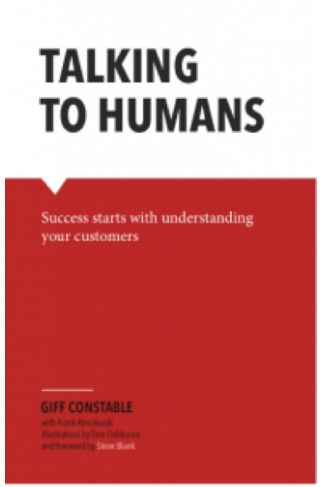Talking to Humans: Success Starts with Understanding Your Customers
Editor’s note: The 2015 Lean Startup Conference is just around the corner (it’s from November 16-19th in San Francisco, and there’s still time to get your ticket!). We have dozens of excellent speakers and mentors who are eager to share their product development, entrepreneurship, and innovation stories–you’ll never see these experts in one place ever again. Learn more about them in our ‘Lean Startup Speakers’ series.
Next up is Frank Rimalovski, who is managing director of the NYU Innovation Venture Fund at New York University. He’ll be giving a talk called “Talking to Humans: Success Starts with Understanding your Customers” at the 2015 Lean Startup Conference. Learn more about him here.
In my 16 years as a venture capitalist, I have observed countless teams draft a business plan, build their product, and only after they built it, seek customer feedback. Unfortunately, this “if you build it, they will come” approach almost never works. By the time you have built your product, you have fallen in love with it and likely become deaf to (negative) customer feedback, or you have sunk all your precious time and resources into something few people care about.
The Lean Startup turned this decades-old formula on its head. By securing customer feedback before building your product, entrepreneurs can dramatically increase the likelihood that you build products that customers actually want, and do it more quickly and cheaply.
Since Steve Blank first penned The Four Steps to the Epiphany in 2003, thousands of startup teams have been “getting out of the building” with the intention of testing their minimum viable products (MVPs) in search of product/market fit. While many entrepreneurs have achieved a level of lean startup buzzword compliance, most do not know how to effectively conduct the kinds of interviews and experiments that will lead to the insights they seek (and need). It is amazing to watch even the most introverted engineers, scientists and MBAs all become shameless salespeople as they misinterpret “getting out of the building” with asking customers if they like, or worse, would buy their product. This rarely yields useful insights. In the early stages of customer development the goal is not to validate if someone wants your product, but rather to search for who your initial target customer is, and to gain a deeper understanding of the problems you are solving for these customers.
When I taught lean startup classes and programs to students and faculty at NYU or to NSF I-Corps teams, I saw teams struggle with this time and again, and felt that we needed a way to more explicitly guide entrepreneurs through the process of securing, conducting and synthesizing early customer discovery interviews. I tested this hypothesis the need with my colleagues at the NYU Entrepreneurial Institute, as well as with my fellow I-Corps instructors…and it was clear I had identified a pain point.
Last year, I approached Neo CEO Giff Constable with the idea to turn his blog posts about customer discovery into a short book. He loved the idea, and from there, Talking to Humans: Success Starts with Understanding Your Customers was born.
 While not a text in the academic sense, Talking to Humans was written to complement the other seminal writings on customer development and lean startups: Blank & Dorf’s The Startup Owner’s Manual, and Osterwalder & Pigneur’s Business Model Generation and of course Eric Ries’ The Lean Startup, among others.
While not a text in the academic sense, Talking to Humans was written to complement the other seminal writings on customer development and lean startups: Blank & Dorf’s The Startup Owner’s Manual, and Osterwalder & Pigneur’s Business Model Generation and of course Eric Ries’ The Lean Startup, among others.
I wrote the outline. Giff did the heavy lifting and actually wrote the book (thank you Giff!). I recruited Tom Fishburne to draw these awesome cartoons and Steve Blank to write the foreword. Lindsey Gray and Jerry Hao of the NYU Entrepreneurial Institute provided extensive, invaluable early feedback. We tested our rough draft MVP with 10 student teams in our 2014 Summer Launchpad accelerator, and subsequent draft with another 11 teams in the 5-day Lean Launchpad class I taught that August. We shared early drafts with my fellow I-Corps instructors and other practitioners and educators across the country, and incorporated their feedback and suggestions. It has earned praise from early stage VCs at Flybridge Capital, True Ventures and First Round Capital, as well as from our colleagues at UC Berkeley, University of Maryland, MIT, and of course NYU, among many others. We knew we were on to something when educators and accelerators across the globe were asking to use Talking to Humans in their classes and programs before the book was finished. I am confident we have achieved product-market-fit and found our earlyvangelists!
Giff and I thought long and hard about whether to charge for the book or not, and how that might impact how Talking to Humans was perceived. In the end, we decided to put it out into the world for free, which was consistent with our original goal of giving back to the community. You can get Talking to Humans in PDF or ePub (iBook) for free, on Kindle for 99¢ (Amazon insists we charge something), and in print (at our cost). Order or download it, along with other useful materials, at talkingtohumans.com.
During my talk on Tuesday afternoon at the 2015 Lean Startup Conference I’ll share actionable advice from the book, and lead some useful exercises we’ll do together. Whether you’re an entrepreneur or an educator seeking to share this with other students or startups you work, you’ll leave with a new set of tools to put immediately into practice and/or more effectively share with others.

